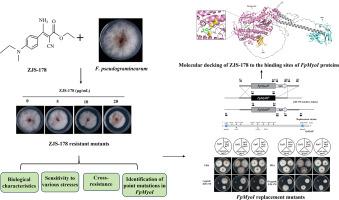伪谷草镰刀菌ZJS-178抗性突变体的特性研究
IF 4
1区 农林科学
Q2 BIOCHEMISTRY & MOLECULAR BIOLOGY
引用次数: 0
摘要
伪谷粒镰刀菌是小麦冠腐病(Fusarium crown rot, FCR)的主要病原。ZJS-178是一种氰基丙烯酸酯类杀菌剂和非那马克利衍生物,对镰刀菌有较强的抑制活性。然而,其耐药风险和潜在的耐药机制仍未被探索。在本研究中,我们在实验室对3株敏感的伪谷草镰刀菌进行了杀菌剂适应,得到了35个ZJS-178抗性突变体,其中22个表现出高水平抗性。与亲本菌株相比,抗性突变体表现出较低的适应性,包括菌丝生长、分生、分生孢子萌发、脱氧雪腐镰刀菌醇生产和毒力受损。交叉耐药分析显示ZJS-178与非那马那利呈正相关,但与氟恶菌尼、戊康唑、多菌灵或丙氯嗪无交叉耐药。序列比对和基因替换试验鉴定出FpMyoI基因(编码肌球蛋白I)的10个点突变是耐药的遗传基础。分子对接分析进一步证实这些突变干扰了杀菌剂的结合。本研究为了解ZJS-178耐药的分子基础提供了重要的见解,并为FCR控制的耐药监测和管理策略提供了有价值的指导。本文章由计算机程序翻译,如有差异,请以英文原文为准。

Characteristics of ZJS-178 resistant mutants of Fusarium pseudograminearum
Fusarium pseudograminearum is a major causal agent of Fusarium crown rot (FCR) in wheat worldwide. ZJS-178, a cyanoacrylate fungicide and phenamacril derivative, has shown strong inhibitory activity against Fusarium species. However, its resistance risk and underlying resistance mechanisms in F. pseudograminearum remain unexplored. In this study, three sensitive F. pseudograminearum isolates were subjected to fungicide adaptation in the laboratory, resulting in 35 ZJS-178 resistant mutants, 22 of which exhibited high-level resistance. Compared to their parental strains, resistant mutants displayed reduced fitness, including impaired mycelial growth, conidiation, conidial germination, deoxynivalenol production, and virulence. Cross-resistance analysis revealed a positive correlation between ZJS-178 and phenamacril, but no cross-resistance with fludioxonil, tebuconazole, carbendazim, or prochloraz. Sequence alignment and gene replacement assays identified 10 point-mutations in the FpMyoI gene (encoding myosin I) as the genetic basis for resistance. Molecular docking analysis further confirmed that these mutations interfere with fungicide binding. This study provides critical insights into the molecular basis of ZJS-178 resistance and offers valuable guidance for resistance monitoring and management strategies in FCR control.
求助全文
通过发布文献求助,成功后即可免费获取论文全文。
去求助
来源期刊
CiteScore
7.00
自引率
8.50%
发文量
238
审稿时长
4.2 months
期刊介绍:
Pesticide Biochemistry and Physiology publishes original scientific articles pertaining to the mode of action of plant protection agents such as insecticides, fungicides, herbicides, and similar compounds, including nonlethal pest control agents, biosynthesis of pheromones, hormones, and plant resistance agents. Manuscripts may include a biochemical, physiological, or molecular study for an understanding of comparative toxicology or selective toxicity of both target and nontarget organisms. Particular interest will be given to studies on the molecular biology of pest control, toxicology, and pesticide resistance.
Research Areas Emphasized Include the Biochemistry and Physiology of:
• Comparative toxicity
• Mode of action
• Pathophysiology
• Plant growth regulators
• Resistance
• Other effects of pesticides on both parasites and hosts.

 求助内容:
求助内容: 应助结果提醒方式:
应助结果提醒方式:


